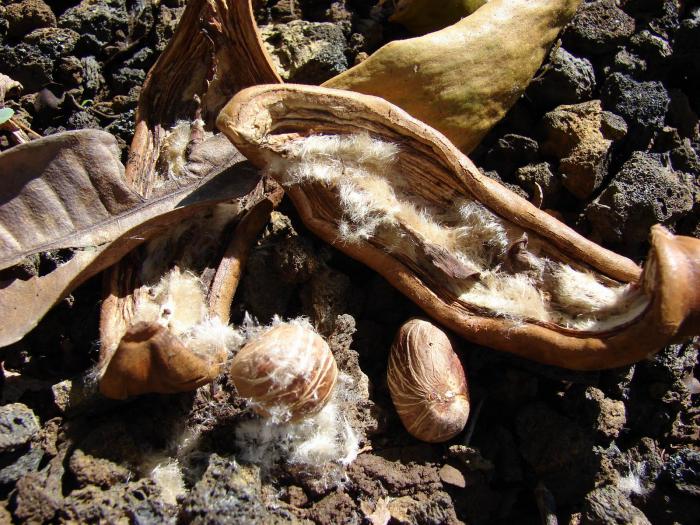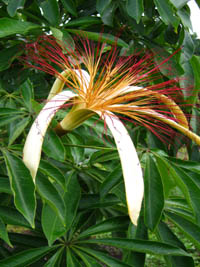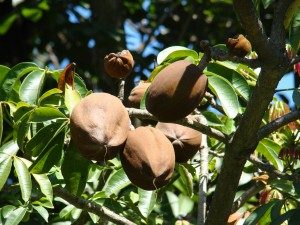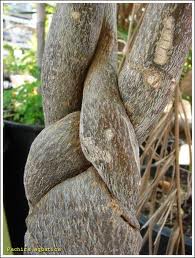My foraging existence is slightly schizophrenic. I grew up in a northern climate, and I write about many northern plants, or it is accurate to say that the majority of the plants I write about are found in northern climes. Conversely I live in Florida, which is a different land altogether. Thus I am biclimatic, having spent 42% of my life in the north and 58% in the south… thus far.
A 400-mile long state, Florida has three distinct climates, temperate, subtropical and tropical. I can go 200 miles north or south and find extremely different plant communities, species that will grow in one place but not the other. One reason why I expanded my classes into southern Florida was to learn more about the tropical there, and this tree is one of them, the Pachira aquatica, formerly Bombax glabrum and a few other scientific names as well. The nomenclature nonsense does not stop there with several common names for the Mallow Family member: Guiana Chestnut, Malabar Chestnut, Provision Tree, Saba Nut, Monguba, Pumpo, Money Tree and Money Plant.
Pachira aquatica (pack-EYE-rah ah-QUAT-tic-ah) is native to Central and South American and quite at home in southern Florida and Puerto Rico. It’s also cultivated in southern California and Hawaii. Growing close to 60 feet in the tropical wild, it’s cultivated for its edible seeds that grow in a large, woody pod. Out of the pod the seeds are shaped somewhat like chestnuts and taste similar when cooked, hence the common name. They also are covered with many white stripes, making them fairly easy to identify. The seeds’ flavor when raw is similar to peanuts. They can be eaten raw or cooked, or ground into flour. The cooked young leaves and flowers are also edible.
Calling the species the Money Tree or the Money plant is an innovation of the last 25 years or so. In 1986 a Taiwanese truck driver put five small seedlings into one pot and weaved them together as they grew. He inadvertently invented the next hot ornamental plant and business took off in Taiwan, Japan and most of eastern Asia. The braided tree is viewed as associated with profit and is a common plant found in businesses, often with red ribbons or other ornaments attached. By 2005 export of the braided tree was a $7 million business in Taiwan.
Why think the tree brings good financial luck? Numerology is still alive and well. The leaves are palmate, with five large leaves which symbolize the five basic Feng Shui elements; Metal, Wood, Water, Fire, Earth. And there are five trees braided together to re-enforce the number 5.
The genus name, Pachira is a Guyana term and aquatica means water. The tree likes to grow in swamps.
Green Deane’s Itemized Plant Profile
IDENTIFICATION: A spreading tree to 60 feet. Greenish bark and shiny, dark green compound leaves resembling a Schefflera. Flowers from a foot long bud, usually hidden by foliage. Five cream-colored petals of the large flowers droop revealing red-tipped off-white stamens. Those change to football-shaped woody pods that can reach a foot in length and half a foot in diameter. Tightly packed seeds in the pod enlarge until about a half inch in diameter causing the pod to crack open. Easily started from seed.
TIME OF YEAR: Flowers late fall or early winter, fruits in the spring
ENVIRONMENT: Does best in areas of periodic flood, or if water heavily often. It does not like dry wind, may endure temperatures briefly down to 28F.
METHOD OF PREPARATION: Seeds edible when the pod cracks open, raw or cooked or ground into flour. Seeds raw taste similar to peanuts. Roasted or fried they taste similar to chestnuts. Young leaves and flowers edible cooked, usually by boiling.







Hi
Did you know there are different varieties of the “money tree?” ….The fruit from my tree is green. The brown fruit pictured in the tree your article is another variety
I like chestnut because of it nutritional value
My chestnut appeared brownish with white stribes
Warm greetings, my husband and I are visiting Cuba next month. (He’s Cuban and hasn’t been back since his family fled in 1961.) I am G.I.-challenged and hope to find plenty of edible greens when there. I’ve been told there aren’t many greens to eat in stores and restaurants. Can you recommend a book or resource for southern Florida?
I will try searching your site using ‘florida’ and see what happens. Thanks!
Thanks for this information! I have one of these trees, and the first time I ate the nuts was fine. They tasted good. So I planted a bunch of seeds, thinking I’d have a major source of food. But the next two times I tried eating the nuts, I felt very nauseated for several hours, with unpleasant consequences. Could it be that I’m allergic to them? I don’t have any other food or nut allergies. Or perhaps I got one that wasn’t ripe enough? Have your heard of this happening to others? I’m afraid to try eating it again.
Several questions come to mind such as which part are you eating? Where were they planted? Was this from different trees?
I’m looking around the web for more information right now, but I read on another website that the seeds may be toxic unless the embryo of the plant is removed. You might have been eating the supposedly toxic embryos.
Hey I just spent 2 weeks researching the web for tropical nut trees and we found that Rare flora in DelRay Beach sells a hiphigh pachira for $30. We got ours and are trying to keep it well watered. Glad to see your article on it!
Thanks for the information about this plant, pachira. Iam aware that there is pachira glabra and pachira aquatica. Which one is having the toxic material in the embryo? because I happen to have pachira glabra in my farm and Iam an activist in the global tree planting agenda and I would like to give people something good and safe. please,
I have been informed that the tea of the bark of Pachira acuatica (“zapoton”, which grows in swampy areas in the humid tropics) taken regularly for some time helps fight back or cure pain problems. Has anyone experienced this? Thank you. Cheers.
Any concerns that this tree could become invasive in Florida? It is apparently adapted to swampy conditions and tolerates the south Florida climate.
I was able to acquire a paquira (brown pod and red tipped flowers kind) that was about a foot high a year ago. It had quite a bit of root bound damage and I didn’t think it was going to make it. Wow was I wrong. It took about 7 months to spring back but by the time the monsoon season came in Florida it took off and is producing beautiful flowers. It’s only about 3 ft tall!
Quote
“Five out of six rats fed on P. aquatica diet died within 6–8 days. The remaining rat experienced enlargement of the stomach, liver, pancreas, kidneys, heart and lungs and had spleen atrophy when compared with the same organs of rats fed on egg-white diet. Hypertrophy of the pancreas and kidneys was very marked and these organs nearly doubled in dry weight in comparison with those of the egg-white control group, demonstrating that the raw seed of P. aquatica are highly toxic when fed to rats even at a meal protein concentration half that of S. striata or T. catappa, which were better tolerated by the experimental animals.”
Source:
https://www.researchgate.net/publication/223721020_Composition_and_nutritional_properties_of_seeds_from_Pachira_aquatica_Aubl_Sterculia_striata_St_Hil_et_Naud_and_Terminalia_catappa_Linn
“
Those are rats. Humans eat the seeds without issue.
The cyclopropenoid fatty acids are the main toxin in Pachira and are around 30% of the oil content. By contrast they are only present at 1-2% in cotton seed. They have known detrimental effects on a range of different species (eg see https://www.cambridge.org/core/services/aop-cambridge-core/content/view/S0029665166000119) and I can’t find any detailed work on their health effects in humans. I agree that eating a handful of pachira nuts every now and then will probably have no obvious effect, but I think it is reasonable to expect that if someone ate them on a regular basis they would suffer some ill effects. In Brazil they are treated as a famine food apparently.
I imagine a large chunk of the foods we eat would kill you if you ate *only* that food.
It’s also worth pointing out that there’s a lot of confusion with P. aquatica and P. glabra. The vast majority of what’s marketed as P. aquatica / money plants is actually P. glabra. Pods for P. glabra are smaller and green, while for P. aquatica they’re larger and brown. Flowers from P. glabra are pure white, while those from P. aquatica are red. P. glabra develops more of a swollen base and has more green in its trunk, while P. aquatica is less prone to it and is more brown.
The reports on edibility are very mixed. I’ve never seen a source disputing that they’re fine cooked, but every now and then you see a report suggesting that they’re not good to eat raw, even though some people enjoy them raw. Things I’ve seen this blamed on are claims that A) P. glabra can be eaten raw but not P. aquatica; and B) you have to remove the embryo (but I know some people don’t do that and are just fine). Maybe a combination of A) and B)? Hard to say. That said, most people agree that they’re tasty nuts.
Have Guiana chestnut tree 30 foot tall has fruited once with a 20 inch large fruit during its 10 year life, how do we encourage fruiting, it flowers twice yearly with 12 inch white and purple blooms.
2021, and this is the second time the boughten bulbous based pachira has fruited, although it has borne flowers every couple months.I also have a pachira grown from a nut which actually looks like the pix of pachira nuts. There are spaces of tree about 4-6 feet long, then a radiating spoke of branches, then the bare tree trunk, then a radiating spoke of branches. Those nuts from the seedling haven’t ripened yet. The other, boughten pachira has more random based branching and the pods come off somewhat larger than a softball and then the nuts inside the secondary interior shell are about the size of a child’s fist. The hard skin is dark brown and where I peel it away the nut is either purplish or green. One of the nuts had sprouted, I uprooted it to move to a pot. Since there are so few, larger, differently colored nuts, are these still edible Pachira? I don’t want to poison us. Google doesn’t seem to want to find “relatives of Pachira”. Any help from anyone would be appreciated- I have 2 huge bowls of the large nuts soaking to get skin off right now.
Got a picture here like the nuts off the “boughten” Pachira, which I pulled up googling GLABRA
OOps, didn’t work. I think I have 1 pachira aquatica and one glabra. Glabra gave us the fruits where the inner pod holds larger nuts that resemble a brain. The nuts wherethe paper is peeled off is either purcplish or green, and the size of a preschoolers first. Hopefully they are edible?? as that’s what we were trying for, recognizing that California nut ranchers were pulling out mature bearing almonds because of the drought in 2013..